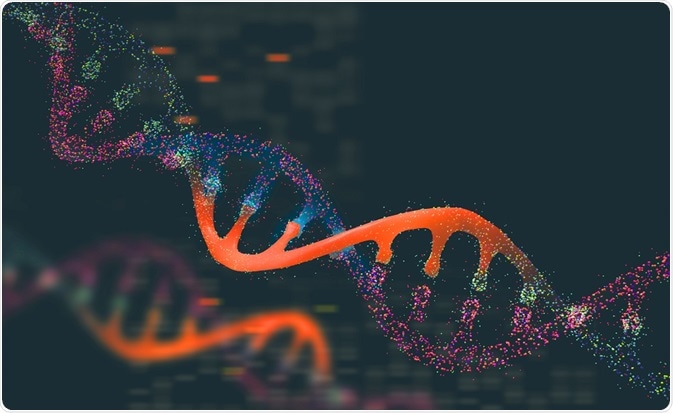In diploid organisms, two copies of a gene are inherited − one from the mother and one from the father. For most genes, both alleles are expressed, but in a small subset, only one of the copies are expressed whilst the other is inactive. This is termed genomic imprinting.

Credit: Yurchanka Siarhei/Shutterstock.com
Genomic imprinting means that specific genes inherited from the mother or father are active, whilst the gene inherited from the other parent is inactive. This preferential expression of one allele is important for normal development. Genomic imprinting is found in all mammals and investigation of this process has been aided by the presence of many conserved imprinted genes between mice and humans.
Genomic imprinting and development
The role of genomic imprinting in development was first noted in uniparental mouse embryo studies. Embryos derived from two paternal pronuclei were found to lack embryonic tissues whilst the embryos derived from two maternal pronuclei developed without extraembryonic tissues.
This indicated that imprinted genes with preferential expression of one inherited allele (either paternal or maternal), were central to normal development. The paternally expressed IGF2 gene was one of the first imprinted genes to be identified as a positive regulator of fetal growth. Interestingly, it’s expression is controlled by the maternally imprinted IGF2R gene.
Imprinted genes also have an important role in neural development and function. Genomic imprinting provides unique gene expression in the brain that is separate from patterns seen in other tissues. One example is the UBE3A gene where both copies are expressed in most tissues but only the maternal copy is expressed in brain tissue where it promotes neural plasticity. Some imprinted genes are associated with specific neuronal subtypes that assist in the establishing diverse cell types within the brain tissue.
Imprinting mechanisms
Genomic imprinting occurs through the marking of a gene during gamete production via different epigenetic mechanisms. Two major mechanisms by which genes are imprinted are DNA methylation and histone modifications. During DNA methylation, a methyl group is added to a segment of DNA and is employed in the identification of a maternal or paternal allele.
The epigenetic process alters gene expression through imprinting without altering the DNA sequence. Histone modifications alter the chromatin structure leading to changes in gene expression. There are numerous modifications that can be applied to the histone for imprinting including histone acetylation, which forms an accessible chromatin formation, and histone deacetylation leading to compressed chromatin.
After fertilization, specific imprints from each parent must be maintained during genome reprogramming. The final stage of genomic imprinting involves the erasure of the somatic pattern of biparental imprints.
Genomic imprinting and disease inheritance
Some diseases occur as a result of deletions or mutations in imprinted genes. Prader-Willi syndrome and Angelman syndrome were the first reported diseases associated with genomic imprinting in humans. The diseases have distinct symptoms though they are both caused by a deletion in the same region of chromosome 15. This is because the parental origin of the affected chromosome differs between the two syndromes.
Prader-Willi syndrome is caused by the loss of paternally inherited genes whilst Angelman syndrome is caused by the loss of maternally inherited genes. The loss of paternally imprinted genes can occur because of unipaternal disomy, in this case where two copies of the maternal chromosome are inherited. In contrast, Angelman syndrome occurs through the loss of the single maternally expressed gene UBE3A within brain tissue.
Genomic imprinting is also associated with the formation of certain cancers. A type of embryonic kidney cancer called Wilm’s tumor is associated with the loss of imprinting for two specific genes.
In normal embryonic kidney cells, the imprinted maternal copy of H19 is expressed that has a growth suppression function along with the imprinted paternal copy of IGF2, a known growth factor. In Wilm’s tumor cells the imprinting of H19 and IGF2 is lost, meaning that the lack of H19 function causes an overexpression of IGF2 resulting in tumorigenesis.
Sources:
- Plasschaert, R.N. & Bartolomei, M.S. 2014. Genomic imprinting in development, growth, behavior and stem cells, Development, 141, pp. 1805-1813.
- MacDonald, W.A. 2012. Epigenetic Mechanisms of Genomic Imprinting: Common Themes in the Regulation of Imprinted Regions in Mammals, Plants, and Insects, Genetics Research International, 1, e585024.
- Hanna, C.W. & Kelsey, G. 2017. Genomic imprinting beyond DNA methylation: a role for maternal histones, Genome Biology, 18, e177.
- Lobo, I. 2008. Genomic Imprinting and Patterns of Disease Inheritance, Nature Education, 1:66.
Further Reading